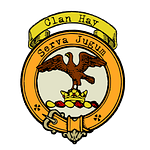Welcome back to "A Clan A Day Podcast," brought to you by bagtownclans.com. I’m your host, Colin MacDonald, and today, we’re exploring the rich tapestry of history woven by Clan Shaw—a proud member of the Chattan Confederation and a Highland family renowned for their courage, resilience, and enduring legacy.
The story of Clan Shaw begins in the 12th century with their progenitor, Shaw MacDuff, a younger son of Duncan, the Thane of Fife. Shaw MacDuff was entrusted by King Malcolm IV with the crucial role of Keeper of Inverness Castle. His descendants, known as the Mhic an Toiseach—“Sons of the Thane”—solidified their power in the Inverness area, eventually acquiring lands at Rothiemurchus in 1263. From these strategic lands in Strathspey, the Shaws began their rise to prominence.
The Shaws’ reputation as fierce warriors was cemented during the 14th century. Shaw Macghillechrist Mhic Iain, known as Shaw “Bucktooth,” emerged as a formidable leader. Raised among his cousins, the Mackintoshes, Shaw earned renown in two critical conflicts: the 1370 Battle of Invernahavon, where Clan Chattan clashed with Clan Cameron, and the legendary 1396 Battle of the North Inch. This trial by combat pitted thirty warriors from Clan Chattan, led by Shaw, against thirty from Clan Cameron before King Robert III and the French Dauphin. Shaw’s leadership was instrumental in securing victory, earning him the lease of Rothiemurchus from his cousin, the chief of Clan Mackintosh.
Rothiemurchus, nestled in the heart of the ancient Caledonian Forest, became the seat of Clan Shaw. However, the clan's position was not without challenges. The powerful Comyns sought to dominate the region, igniting a bitter feud. James Shaw of Rothiemurchus fell in the 1411 Battle of Harlaw, fighting alongside the Mackintoshes for the Lord of the Isles. His son, Alasdair Ciar, avenged his father’s death by defeating the Comyns in a fierce skirmish at Laggan na Chuiminaich. Alasdair secured permanent rights to Rothiemurchus in 1464, marking the beginning of the Shaws’ independent leadership.
From Rothiemurchus, the Shaws expanded. Alasdair’s younger brother, Adam, founded the Tordarroch branch, known as Clan Ay. This branch played a pivotal role in Clan Chattan affairs, with Robert Shaw of Tordarroch signing key bonds of manrent in the 16th century. Other branches, including the Shaws of Dell, Dalnavert, and the Western Isles, contributed to the clan’s influence. The Farquharsons, a powerful clan in their own right, trace their lineage to Farquhar, a younger son of Alasdair Ciar.
Clan Shaw’s martial spirit endured into the Jacobite era. During the 1715 Rising, Robert Shaw of Tordarroch and his brother Angus led a disciplined contingent for the Jacobites. Imprisoned after the rebellion’s failure, Robert died soon after his release, while Angus was exiled to Virginia. By the 1745 Rising, Clan Ay refrained from participating under Angus Shaw’s leadership, but many Shaws from Deeside and Rothiemurchus fought valiantly, including James Shaw of Crathienaird.
The loss of Rothiemurchus in 1567 to the Grants was a devastating blow to the Shaws. Despite attempts to reclaim the land, it remained with the Grants, marking the beginning of the clan's territorial decline.
Clan Shaw is distinguished by its motto, Fide et Fortitudine—“By Faith and Fortitude”—and its emblematic plant badge, the red whortleberry. Their pipe tunes, including The Rothiemurchus Rant, celebrate the clan's roots.
The grave of Shaw Bucktooth in Rothiemurchus remains a poignant symbol of the clan’s legacy. Surrounded by five heavy stones, it is said to bring misfortune to those who disturb it. In 1983, an iron cage was added to protect visitors from the supposed curse of the grave.
Today, Clan Shaw continues to thrive under the leadership of Iain Shaw of Tordarroch, the 23rd Chief. The clan is part of the Clan Chattan Confederation, preserving its heritage and fostering connections among members worldwide.
From their ancestral lands in Rothiemurchus to their participation in pivotal moments of Scottish history, Clan Shaw exemplifies the courage, loyalty, and resilience of the Highland clans.
Thank you for joining us on this journey through the history of Clan Shaw. Be sure to tune in tomorrow as we explore another chapter in Scotland’s rich clan heritage. I’m Colin MacDonald, and as always, Go n-éirí an bóthar leat!













Share this post